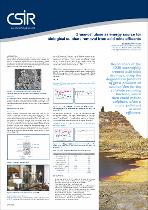 ResearchSpace
ResearchSpace
Grass-cellulose as energy source for biological sulphate removal from acid mine effluents
JavaScript is disabled for your browser. Some features of this site may not work without it.
- ResearchSpace
- →
- Research Publications/Outputs
- →
- Conference Publications
- →
- View Item
| dc.contributor.author |
Greben, HA

|
|
| dc.contributor.author |
Sigama, NJ

|
|
| dc.date.accessioned | 2008-11-26T06:33:28Z | |
| dc.date.available | 2008-11-26T06:33:28Z | |
| dc.date.issued | 2008-11 | |
| dc.identifier.citation | Greben, HA and Sigama, NJ. 2008. Grass-cellulose as energy source for biological sulphate removal from acid mine effluents. Science real and relevant: 2nd CSIR Biennial Conference, CSIR International Convention Centre Pretoria, 17 & 18 November 2008, pp 1 | en |
| dc.identifier.uri | http://hdl.handle.net/10204/2628 | |
| dc.description | Science real and relevant: 2nd CSIR Biennial Conference, CSIR International Convention Centre Pretoria, 17 & 18 November 2008 | en |
| dc.description.abstract | The biological sulphate removal technology requires carbon and energy sources to reduce sulphate to sulphide. Plant biomass, e.g. grass, is a sustainable source of energy when cellulose is utilised during anaerobic degradation, producing volatile fatty acid (VFA) and hydrogen (H2). This process involves cellulose utilising microorganisms, present in the guts of ruminants | en |
| dc.language.iso | en | en |
| dc.subject | Grass-cellulose | en |
| dc.subject | Biological sulphate removal | en |
| dc.subject | Acid mine effluents | en |
| dc.title | Grass-cellulose as energy source for biological sulphate removal from acid mine effluents | en |
| dc.type | Conference Presentation | en |
| dc.identifier.apacitation | Greben, H., & Sigama, N. (2008). Grass-cellulose as energy source for biological sulphate removal from acid mine effluents. http://hdl.handle.net/10204/2628 | en_ZA |
| dc.identifier.chicagocitation | Greben, HA, and NJ Sigama. "Grass-cellulose as energy source for biological sulphate removal from acid mine effluents." (2008): http://hdl.handle.net/10204/2628 | en_ZA |
| dc.identifier.vancouvercitation | Greben H, Sigama N, Grass-cellulose as energy source for biological sulphate removal from acid mine effluents; 2008. http://hdl.handle.net/10204/2628 . | en_ZA |
| dc.identifier.ris | TY - Conference Presentation AU - Greben, HA AU - Sigama, NJ AB - The biological sulphate removal technology requires carbon and energy sources to reduce sulphate to sulphide. Plant biomass, e.g. grass, is a sustainable source of energy when cellulose is utilised during anaerobic degradation, producing volatile fatty acid (VFA) and hydrogen (H2). This process involves cellulose utilising microorganisms, present in the guts of ruminants DA - 2008-11 DB - ResearchSpace DP - CSIR KW - Grass-cellulose KW - Biological sulphate removal KW - Acid mine effluents LK - https://researchspace.csir.co.za PY - 2008 T1 - Grass-cellulose as energy source for biological sulphate removal from acid mine effluents TI - Grass-cellulose as energy source for biological sulphate removal from acid mine effluents UR - http://hdl.handle.net/10204/2628 ER - | en_ZA |





